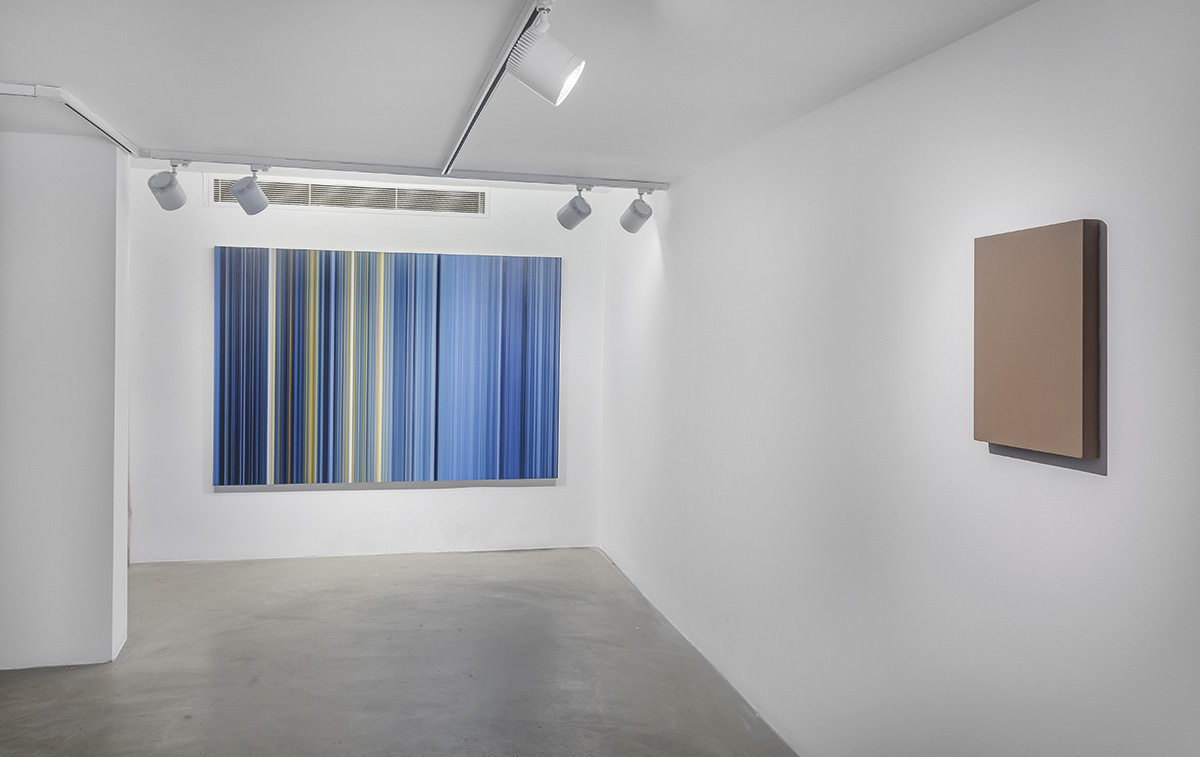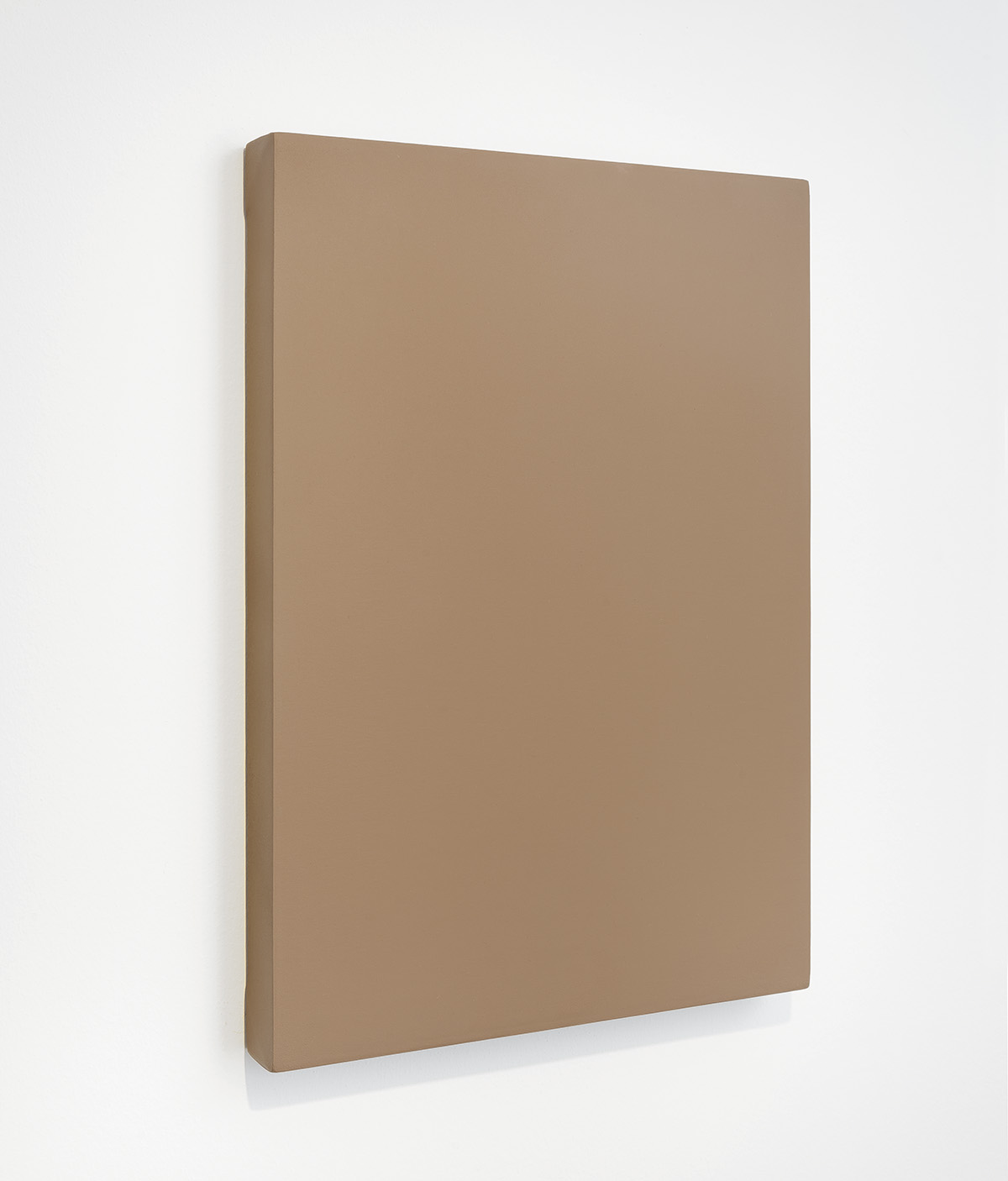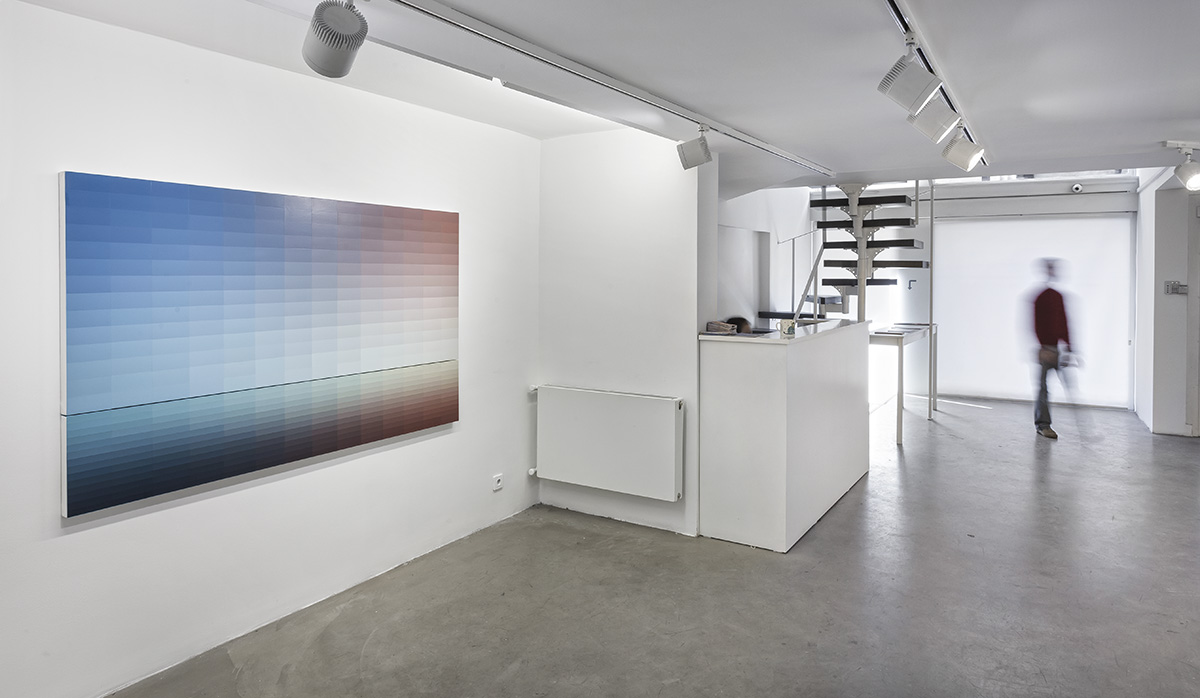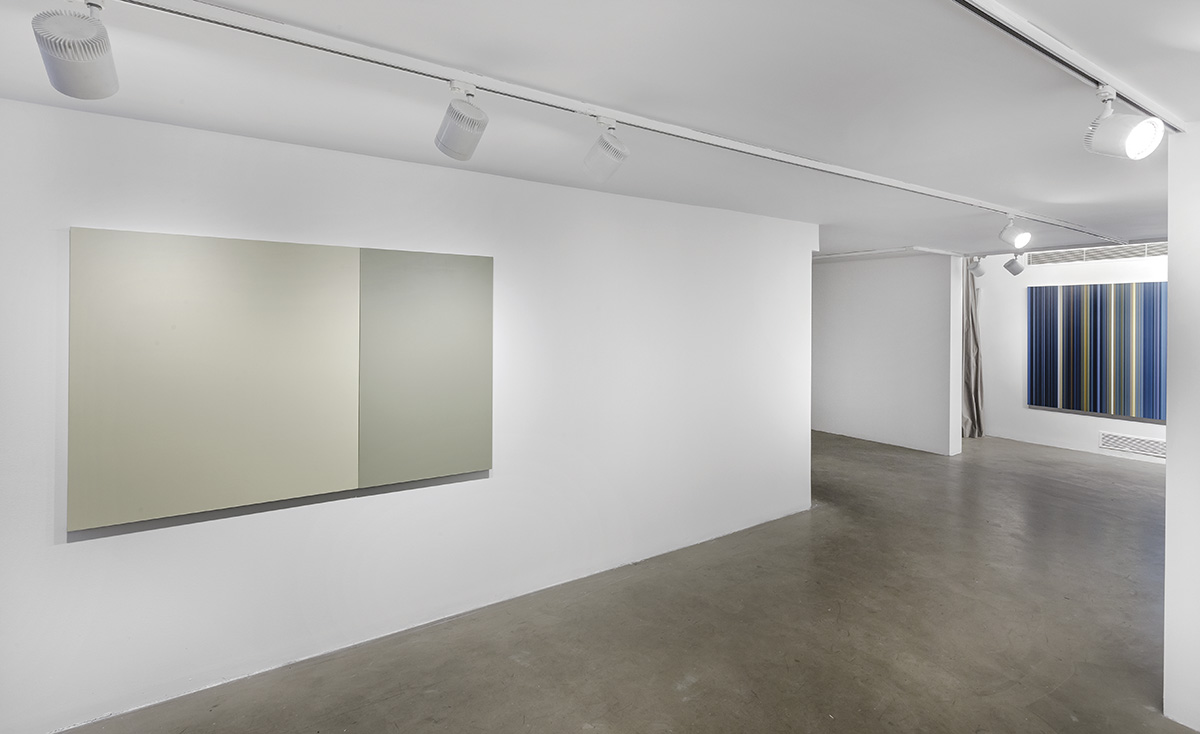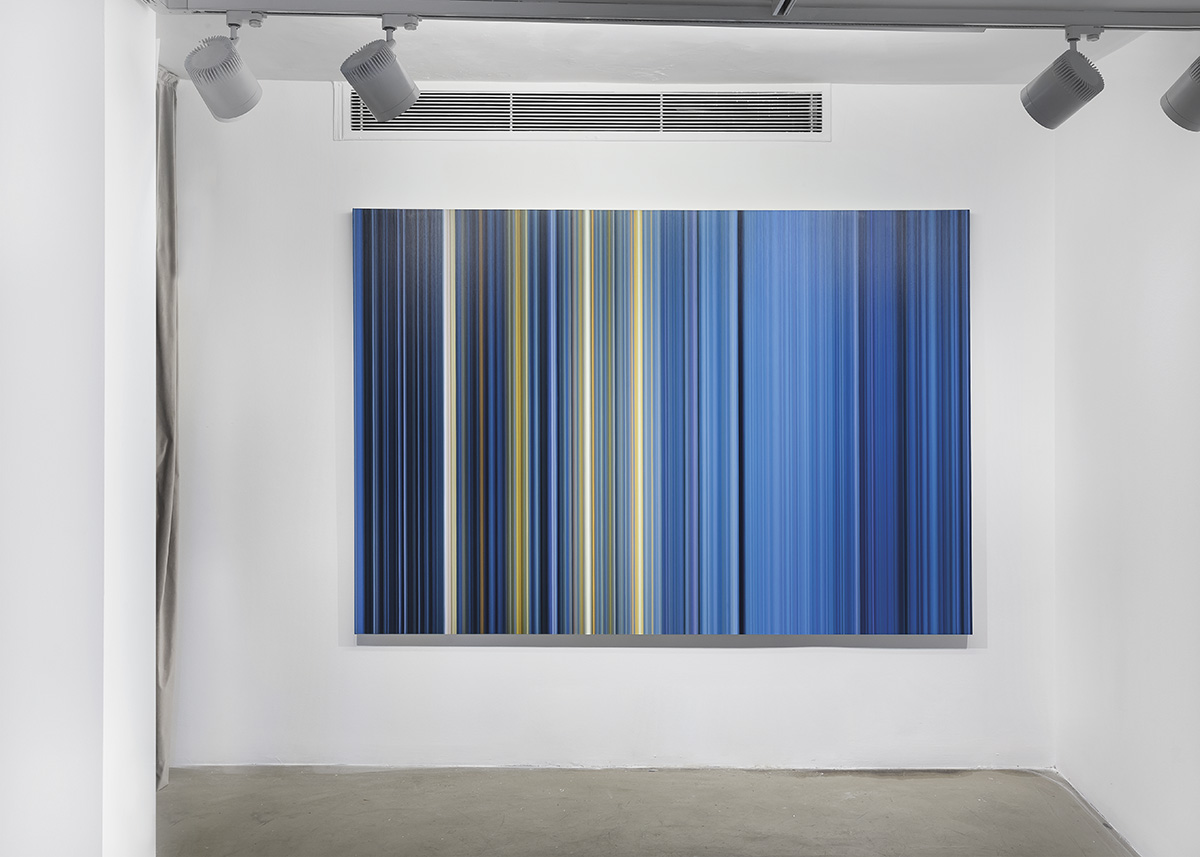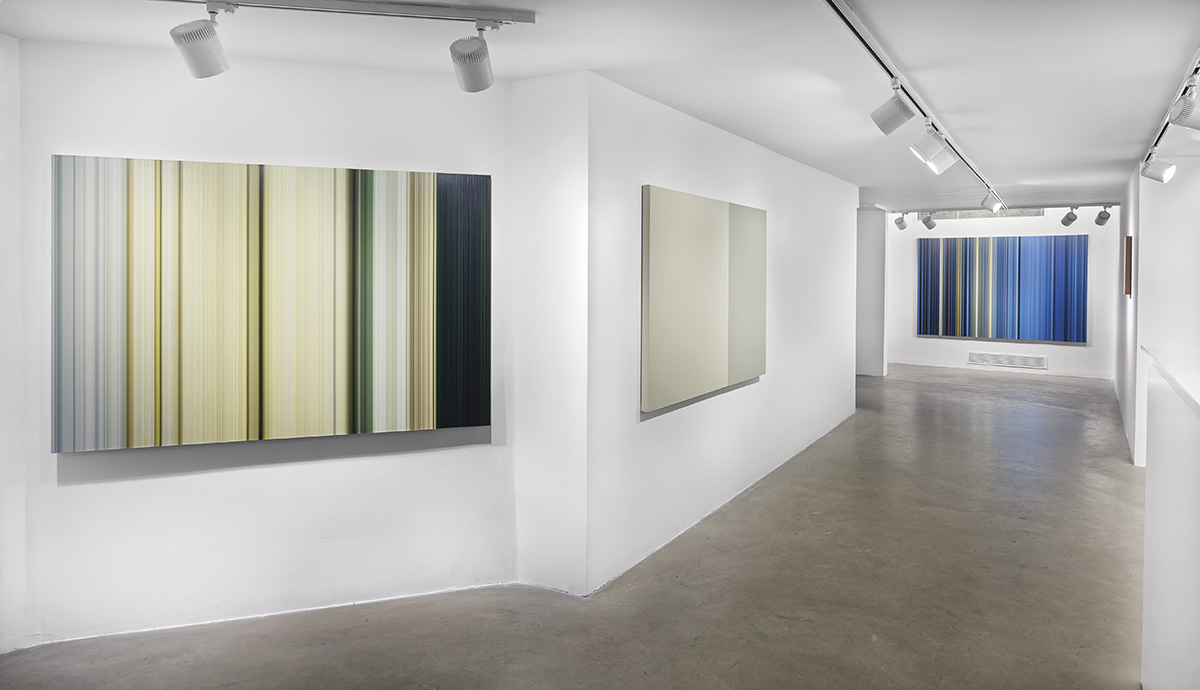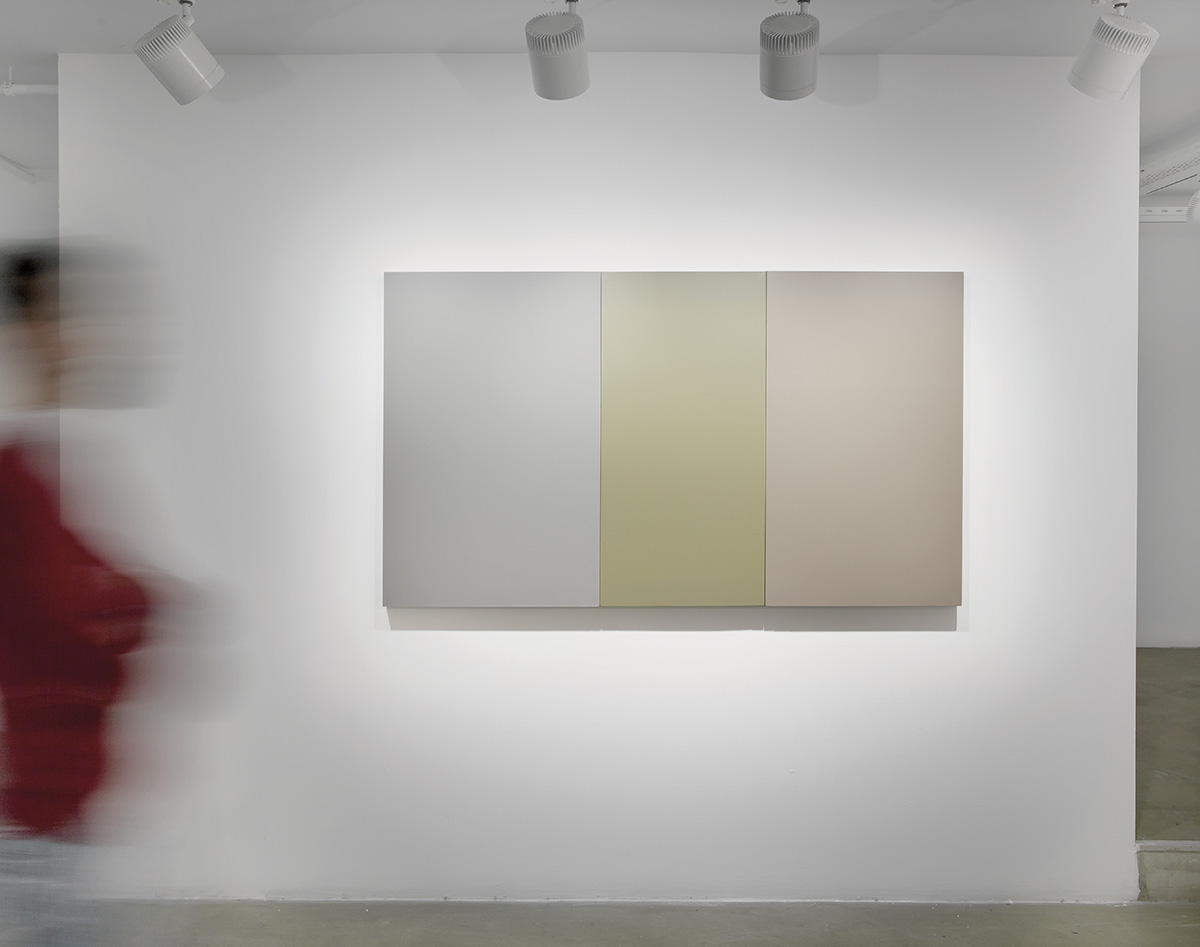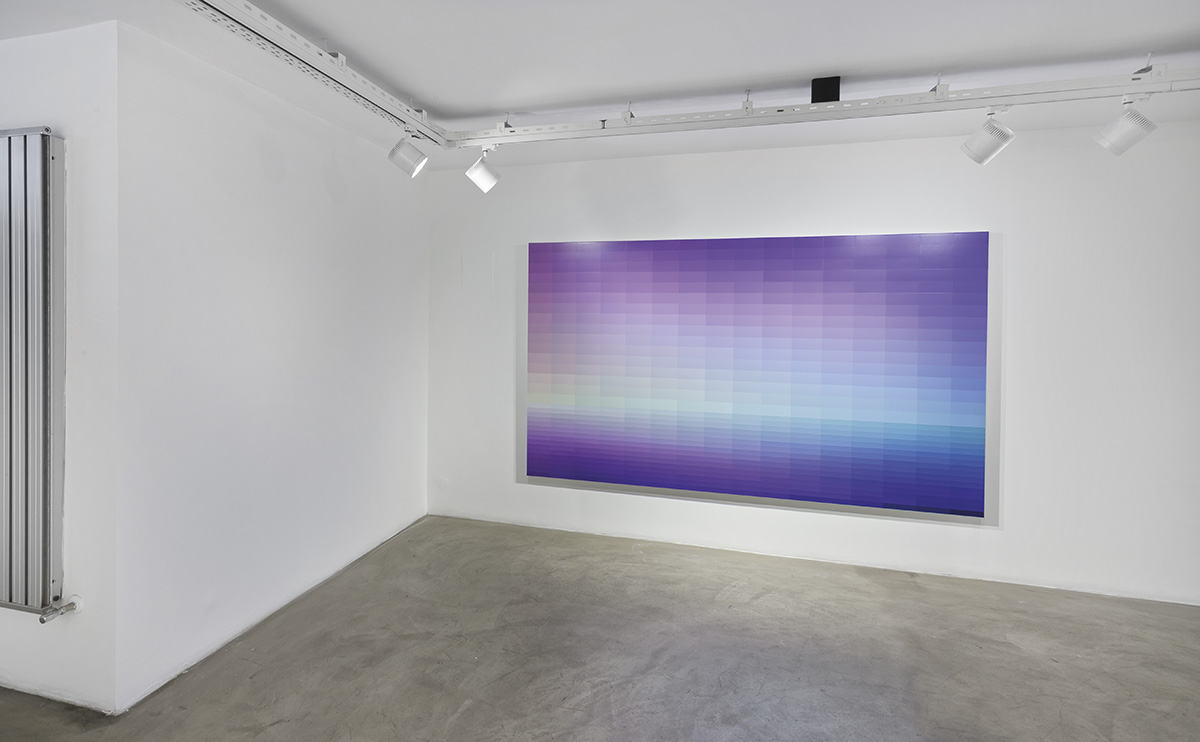AN ESSAY ON YAĞIZ ÖZGEN’S WORKS IN THE CONTEXT OF KANT’S CRITICAL PHILOSOPHY: METADATA
Şeref Erol
“In art it is hard to say anything as good as: saying nothing.”[1]
Ludwig Wittgenstein
This textual work has been produced about the form of exhibition consisting of Yağız Özgen’s artworks in the form of painting brought together by him under the name of “Meta-Data”.
The text will primarily attempt to realize a philosophical analysis related to Yağız Özgen’s most general artistic apprehension within the possibility of some of his paintings.
In this case, this textual work, which will follow two main directions, will approach the accomplishment of its own pattern through some side explanations to be put under these main directions.
Yağız Özgen is one of the artists who shapes himself within the possibility of defining art in the art activities held by the “Definition of Art Group”.
In other words, demonstrating the essence of art through the analysis of art’s grammar is Yağız Özgen’s most general and differential artistic problematic.
In this case, it can be stated that demonstrating the decomposition of art into its formative elements (principles) as art is also included in the artistic approach of Yağız Özgen, such as some art groups or artists.
So, it can be stated that Yağız Özgen’s artworks are on one hand formal in terms of approaching art analytically; however, this shortcut judgement will mislead us. Formal structures are structures which are quintessentially not representative and do not demonstrate anything else than themselves (meaningless structures).
However, it cannot be said that in this context Özgen’s paintings are merely formal; the “formality” is put forward as a problematic in his works.
In other words, in Özgen’s works we can find the representation of the question: “what is form?”
Although paintings are seen as the representation of the nature of form, since the demonstrated form represents that what is present cannot go out of its self-referent structure, it expresses that we do not have a possibility outside the formal structure in hand.
To put it in another way, the only thing that we actualize is that language encodes itself as language; namely, the propositions, which express that language can demonstrate facts, are also about language.
In order to be able to follow such a structure, the problematic created by the notion of “meta-data” should be briefly expressed.
Meta-data are the whole of the informations created about a certain data group; in that case, they themselves should also be accepted as data in this context.
To express it more clearly, in principle, besides being inputs actualized within the possibility of a certain source and carrying information to a certain mind about that source, data have also the opportunity of becoming causes, namely sources, of data through which other data can be created. In this regard, data can be represented each as a fact by other data.
This reasoning can be simplified in the following way:
- Data sources are all beings.
- Data each are also beings.
In that case, - Data are also data sources.
In this case, one can ask how we can know what the first data are (and thereby, about what the first sources, namely, our knowledges are) if the data obtained about data (meta-data) transform the data represented by them into a source.
Although we claim that we have a language that directly represents our daily life through its possibility inside that what is complicated (the factual world that is accepted as being experienced), we do not have the possibility of discovering the axioms that are going to prove this claim.
Unfolding Immanuel Kant’s philosophical argument that states that the whole order of the universe is shaped by us according to our knowledge is necessary to understand this process of reasoning.
According to Kant, the categories of time and space that are pure judgements of our reason are not present in the noumena, namely, in the sources that are the causes of sense-data, which we accept as the reality of the external world; they are assigned to them by our reason itself.
Since we must look at the universe through the glasses of time and space, everything seems to us as data ordered according to time and space. This structure is the categorization, namely the ordering of facts, or noumena, by reason as Kant expresses it. If we could be having an experience of the external world in its form that has not been subjected to the categoric order by reason, we would not be able to answer the question of where the abstract structure of mathematics, which includes the notion of infinity, originates from, because the idea of mathematical infinity, of which experiment is not possible, exists in human mind.
According to Kant, our reason synthesizes from the pure judgements of reason; the infinity of geometry from the judgement of infinity of space, and the infinity of arithmetic from the judgement of infinity of time. Thereby, according to Kant, mathematics (arithmetic and geometry) as a (synthetic) structure, which is not possible in the experience of the external world (that which is a priori) but is only constructed within the possibility of reason, is a synthetic a priori judgement and constitutes the conditions of all our experiences.
In that case, it can be stated that the data originating from noumena pass through the mind’s filter of time and space by way of being mathematized and constitute our universe, namely the phenomena, with this order.
The following question might be asked with the judgement that it is impossible to sense any other reality than phenomena: If noumena are the sources of our knowledge but phenomena are the result of it, then what are the things that should be accepted as data? Those coming from noumena to the first judgements of reason, or those that are received by our consciousness, that constitutes our knowledge, after they pass through these judgements?
According to Kant, data certainly come from noumena but the sources of our knowledge are what our reason puts on those coming from the world of noumena in a way that brings order. In other words, data come to our knowledge from the pure visions of our reason and they are again the ones to be known as a result of analyzing the experience of phenomena; namely, they are the pure laws of reason. So, this reasoning expresses that we are merely inside the same form. If we unfold this inference:
Those coming from noumena as knowledges of pure reason are obtained by means of being put in order (and thus in a changed way) within the possibility of the knowledge of pure mathematics (order of time and space within the possibility of numbers and geometry) and the knowledge of pure nature (causality), and therefore our knowledge is not about noumena but about our own conditions of obtaining knowledge, which happens within the possibility of the experience of phenomena.
The first source of knowledge is certainly the experiment. However, the thing of which experiment is possible (phenomenon) is formed through the order brought by the filter of reason. By way of being put into relation with each other within the order of reason, sense-data, which come from noumena, turn into the perception that can become the matter of science.
In this case, we can only make the science of what has been put in a certain order only and solely by reason. Thereby, what we can know as those which stay the same and unchanged are the transcendental laws of our reason.
In other words, according to Kant, we stay in our own episteme; our knowledge does not demonstrate the truth of the external world; it demonstrates the structure of reason through what our reason constructs within a consistent order relation.
In that case, we cannot constitute an ontological knowledge; each time we think that we make a statement about the being (onto), we stay in our own epistemological structure. However, the epistemological structure in which we stay is as ontological as the things that are about our epistemes. It can be said that Kant demonstrates the epistemic necessity of reason as its ontology (of reason). In other words, all those that are manifested through this analytic method should also be accepted as the ontological structure of reason. Thereby, it can be said that Kant has built an “episte-ontic” structure about reason. For a mere epistemological analysis, one needs to wait for the studies of Frege, Russell, Wittgenstein and the Vienna circle based on Kant’s influence.
The following can be stated in the context of what can be inferred from those that have been expressed so far:
- The sense-data coming from the noumena are passive; they cannot carry the qualities of things, which are the causes of data, into our mind as they are (directly).
- They constitute our perception by being put in (mathematical and logical) order through the pure knowledges of reason.
- One can only infer this order relation as knowledge from our perceptions that have been put in order by our reason.
- Although at the beginning those that we perceive originate from the possibility of the thing-in-itself, the data (those that we sense as contents of perception) do not represent the things-in-themselves but the order of reason.
- This order does not need to be in the things-in-themselves (noumena) as the sources of data, which are the causes of our knowledge, that have been put in order by means of reason.
- In that case, in terms of what they represent, as a result of the analysis of data as a language, one should accept that it is not the things-in-themselves that are demonstrated but only the structure of reason that is demonstrated.
Thus, it can be stated that the sense-data originating from the noumena are prior to our perception; however, they cannot constitute our content of perception unless they are changed through mental laws; in other words, noumena can never be known.
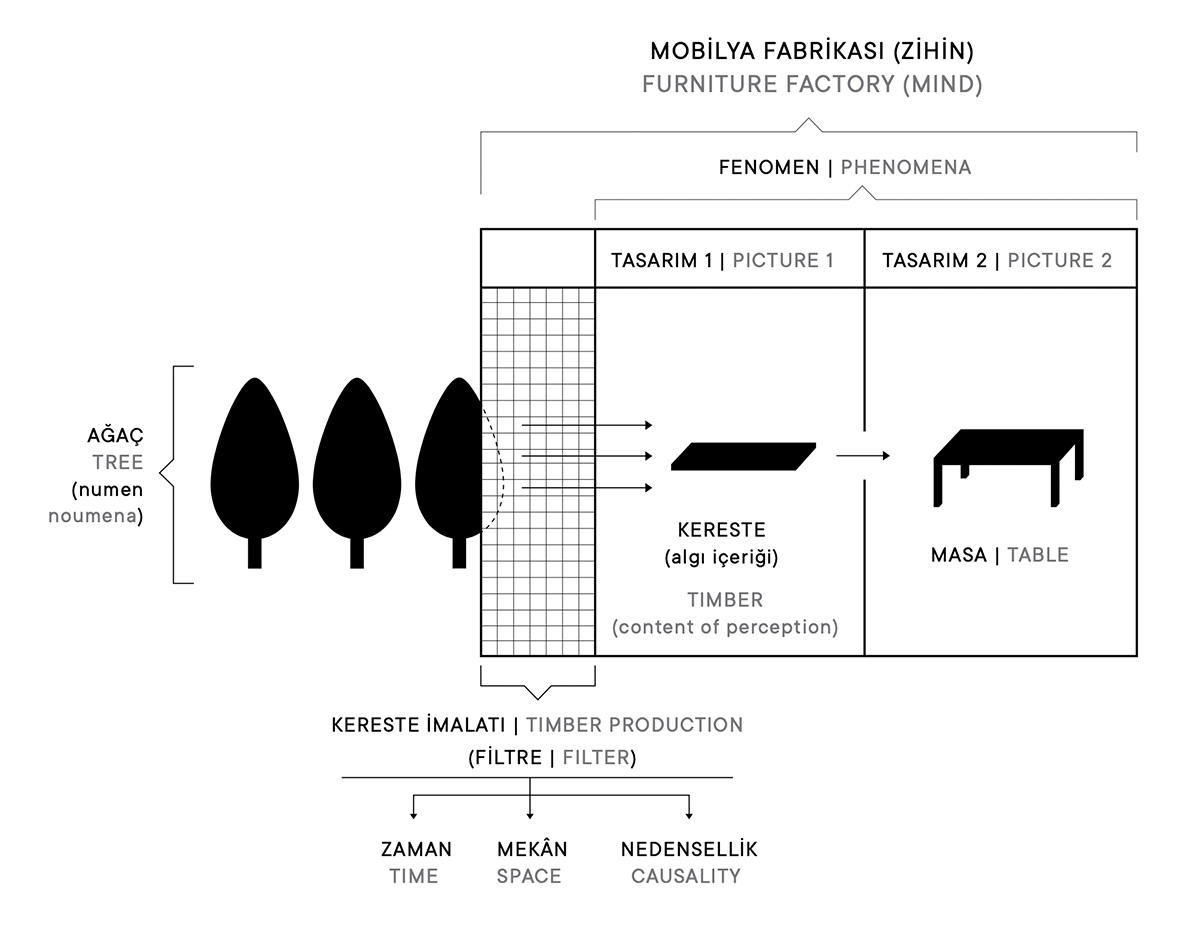
When compared to sense-data, contents of perception are data that we use for constituting our other synthetic judgements, namely our knowledge; their knowable sources are the laws of reason by which they are presented to us.
In that case, it can be stated that those that we sense (phenomena) are a lingual world that has been designed by our reason and is presented to us by reason.
If it needs to exemplify all these expressed above through schematization: Let us assume that our reason is a factory producing a kind of furniture and there exists a forest (world of noumena) consisting of beech trees outside the factory. Now let us think that just the entrance part of the factory (of our reason), that has no direct knowledge of this forest, is a trasforming workplace (pure judgements of reason). Let us think that all the raw materials to come from outside (data from noumena) can only and solely come in as timber (rendered suitable for the order of time, space and causality) by means of being shaped within the possibility of this transforming workplace.
It is impossible for the factory to know what the roughly-cut beech trees – the first data – are. Besides, it is also impossible that it knows the condition of these trees in their own nature as things-in-themselves. The only thing that the factory has knowledge about is timber; however, the ontic integrity of a beech tree in its own nature is not present in the timber, such as the integrated relation that the tree has with the water, the sun, the earth, the seasons, and such as it grows and gives seeds, etc., whereas the timber is like the data carrying the representation of the source of knowledge from which will be derived individual experiences (synthetic – a posteriori experiences) such as the chair and the table. Some features of the timber such as its ability to bend, namely to be shaped, come certainly from the nature of the beech tree (of the noumenon), however, as stated above, these features do not describe the integrated ontic nature of the beech tree.
If the proposition “the beech tree = the shaped being” were true, then the proposition “the shaped being = the beech tree” would also be true by definition of the tautological structure of the proposition. However, not all the shaped beings are beech trees, and the ability of being shaped is only one feature of the beech tree, and not the whole of the facts that completes it.
Now, in this case, when we analyze the world of tables, chairs, etc. (world of phenomena), that constitutes our complex experiences, by way of science and philosophy, we will inevitably accept that the invariables that we obtain are the demonstration of the laws of reason (mathematical and logical laws depending on temporal, spatial and causal relations).
It can be seen from this example that both Russell’s and Alfred Jules Ayer’s definition of object is based on Kantian foundations: According to Ayer, “each of us ‘constructs’ material things out of sense-contents”.[2] While the sense data as invariables constitute the individuality of various objects, it is the relational laws of logic, namely of reason, that present that object to us in a certain order relation (as a form). And according to Russell, “that object that we toy with in our hands is a series of events interconnected with each other through causal relations”.[3] According to this definition, it is stated that the laws of reason put the parts of events in order through “causality relations”. When expressing the variables, that constitute the object, as series of events (beginning and ending within a certain time), he includes time in the definition of the object. Thereby, the object becomes that which one can phenomenologically experiment with, having three spatial dimensions and one temporal one, and where events are associated with each other by reason through causality.
This philosophical system constituted by Kant allows the followers of Kant to successively construct analytic philosophy (linguo-analytical philosophy).
This possibility manifests the most general acceptance that the logical structure of language is prior to our knowledge, and the whole universe, if man is present there, has to comply with the logical order.
In the introduction text of the Turkish translation for Gottlob Frege’s work “Foundations of Arithmetic”, Bülent Gözkan summarizes the a priori feature of logic as follows: “Our language has a logical structure. And when we make a statement about the world, this structure imposes its own structure upon the world and we can only know the world via this imposition. So, everything that concerns our knowledge about the world also necessarily carries elements originating from the own logic of language. Namely, what we can know about the world is not a reality in itself but a reality that emerges through the elements assigned to the world by the own logic of language.[4]
As Bülent Gözkan states it, “transcendental logic investigates the a priori side of the relation of representation”.[5]
This understanding of thought, which developed within Kant’s possibility, matured the tradition of analytic philosophy that has evolved up to Wittgenstein’s following statement: “The limits of my language are the limits of my world.”
For such a perception of universe we can state that the external world represented by language is again the language itself (what the language constitutes). If the language presents its own reality through the external world, then it means that the relation of representation has evolved the other way around of what we consider generally. That what represents is a priori judgements of reason that put those in the mind on that external world rather than presenting to minds those from a source outside the mind.
In this case, data present again their own structure to the mind through those that are possible to experiment with (those that are sensed), by means of being shaped by the mind.
What this analysis shows is that the structure about the universe that surrounds us and what we can obtain from it must be completely formal and analytic. Meaning and sense-making are not part of the functioning of this structure.
We had stated the following about Yağız Özgen’s works: “Although paintings are seen as the representation of the nature of form, since the demonstrated form represents that what is present cannot go out of its self-referent structure, it expresses that we do not have a possibility outside the formal structure in hand.” (p. 3) In that case, we can simplify the mapping of the point of view, that we acknowledge as the result of the Kantian worldview, with such an artistic approach as follows:
- Those that I can know and infer from those that I obtained through “the conditions of sensation of my pure reason” are again “the conditions of sensation of my pure reason”.
- To put it more clearly, this structure, which is cyclic in itself, senses as mediator “the conditions of sensation of pure reason” by means of transforming them into contents of perception and from there again, through analysis, it obtains “the conditions of sensation of pure reason” under the name of “knowledge”.
- This schematic structure describes all possibility of human activity. This activity is the crystal clear vision of the relational order (formal structure) through the simplification of variables in the sensed universe inside a certain order within the possibility of reason.
- The activity of art, science, and philosophy is, most basically, the state of human activity which has been transformed into disciplines.
- In that case, the aim of art is the manifestation of the problematic that the relational structure (that what is formal) is sensed within the possibility of some variables (materials, techniques, etc.), that art can demonstrate, by using that variables.
- In this case, it can be said that art as an activity is a merely mental apprehension.
In that case, Wittgenstein’s expression “In art it is hard to say anything as good as: saying nothing” can be expounded at the point of these inclusions as follows: There has to be an activity held in a demonstrative style so that art can be sensed. The activity that comes out should be concerned with that what is sensed (the form) rather than that through what they are to be sensed (sense-making, meaning and layers of meaning).
Thereby, it should be stated that art, separately from the mind that gives the meaning, is meaningless, namely formal. However, demonstrating something, even if that what demonstrates is reduced in the size of sufficient reason, means saying something and connotes the power of representation rather than the structure of language. No matter how much those that demonstrate are reduced, since they always demonstrate one that is demonstrated, it is difficult for art “to say nothing”. It will be by all means received with a sense-making relation; the necessary meaninglessness of the formal structure will be suspended. In order to better comprehend this approach, it will be explanatory to examine the analogy drawn with the relation between formal structure and meaning by Douglas R. Hofstadter, the editor of the revised edition of Nagel and Newman’s work “Gödel’s Proof”:
“To give an analogy, you might give your car a pet name and even think of it as animate, but the car will function exactly the same with or without its pet name and its putative “soul”; all that matters is the machinery that makes it work. The name and soul have no effect on that machinery, athough they may make it easier for you to relate to your car. As with favourite cars, so with formal calculi.”[6]
What the car analogy demonstrates is that although having no relation to its functioning, sense-making occurs with the meanings assigned to it, namely the functioning of the car. However, one can go further and say the following within the possibility of this example: The parts that provide the functioning of the car (the motor, the carburetor, the differential box, the crankshaft, etc.) have nothing to do with the functioning. The fact that one knows that the continuity of the functioning is provided when any worn-out part of the car is replaced with another suitable one demonstrates clearly that the functioning is not related to the individuality of the replaced part but only to its function. This result can be inferred from the investigations in Arda Denkel’s work “Nesne ve Doğası” [Object and Its Nature, T.N.] about the “identity” problem.[7]
Thereby, it has been demonstrated that, separately from the examples of implementation as well, the functioning (formal structure) is nothing else than itself. Each automobile individual is an example of implementation of a certain form of automobile functioning. Since functioning, which is a relational structure, will find the possibility of being sensed in the ordering that is appropriate to some individual beings’ own structure, all individual beings will make sense to minds within the possibility of only a certain functioning. The functioning itself is not meaningful indeed, but since the functioning will be inferred from the things on which it occurs, these things will be meaningful. Thereby, by denying the reality that the formal structure of the functioning is a mental apprehension, one will think that the functioning is the structure of each individual on which it is implemented. Those that are seen will cover the nature of form.
In the context of those that are expressed above, it can be stated that the demonstrative (sensorial) things that cover the functioning, namely the form, are the necessity of presenting the form. Presenting the form means representing it, and hiding it at the same time. This problematic is the necessity of the practical structure of artworks. Özgen’s artistic awareness at this level is one of the basic reasons of why he simplifies the accidental elements of his works. It can be said that he exposes us to the nature of that what is merely formal to the extent which is possible, namely by trying to say nothing more than sufficient, without going beyond the sufficient conditions of demonstrating an apprehension through art.
If we look at Özgen’s artistic approach within the possibility of what is expressed above, with an eye to his works in the form of paintings, the following can be stated:
In the works, we see primarily that the digital images – images consisting of colour fields that are obtained through digitization by artificial intelligence – are again transformed into data by Özgen by way of transferring them onto the painting. We should add to this expression that the colour fields that have been reshaped in the digital environment and transferred onto the painting, namely the digital images, have been selected from art history. A method of this kind allows an analysis of the works in two separate points:
a- As a result of selecting some works from art history as data and create new artworks by this means, the self-referent, cyclic structure of art as a lingual field is manifested, as Özgen also states it; and in this respect, the object of the work again becomes artwork. In other words, just as, according to Kant, we cannot move from phenomena to noumena except for demonstrating the laws of reason that constitute knowledge, in Özgen’s works as well, art is only possible through an analysis of the structural relations of art; art is a merely self-referent activity as a self-analysis of art. In this context, the works demonstrate the language analysis of an apprehension which problematizes the being of representation, since the representation of language can only represent itself and cannot make a reference to reality.
b- Digitization is the necessity of language, namely, it does not only belong to artificial intelligence that we use as a technological element; the representation of facts by reason through language is completely a digitization. As the variability of the fact is continuous (continuous passing), its reflection to our mind (conceptualization) is discontinuous; in other words, it is numerical. In this context, if one accepts that reason digitizes only the things that are continuous (all beings), it can be said that also the continuous sides of some digital images (discontinuous structures), that are used as data by Özgen for his works, are demonstrated when they become paintings. In other words, as the digitized factual structure (factual structure that is converted into digital code) turns from continuity (in terms of being the fact) into discontinuity (in terms of being the code of language), it also has a continuity at the same as a being-in-itself due to the presence that it gains in the domain of being (it is a fact). So, while, in terms of being the representation of a numerical fact, it is a discontinuous being according to that fact, it is one of those that are continuous in terms of being a being. And it can be asked whether any state of fact (that which is continuous) is the numerical data (that which is discontinuous) of another state of fact? Can one reach the first facts, or even the origins of facts, the objects?
Özgen’s works are the demonstration of an apprehension as art within the possibility of problematizing these contexts.
Translated by Güher Gürmen
[1] The University of Chicago Press, 1980, p. 23e
[2] Alfred Jules Ayer; Language, Truth and Logic, Penguin Books, 1971, p. 55
[3]This has been inferred during the practices of the Definition of Art Group, from Bertrand Russell’s expressions in the definition of object.
[4] Gottlob Frege, Aritmetiğin Temelleri: Sayı Kavramı Üzerine Mantıksal – Matematiksel Bir İnceleme, translated into Turkish by H. Bülent Gözkan, Yapı Kredi Yayınları, 2008, p. 15 [Title in English as “Foundations of Arithmetic: A Logico-Mathematical Enquiry into the Concept of Number”, Northwestern University Press, 1980, T.N.]
[5] Cited from Bülent Gözkan’s presentation held at the IV. Workshop on Logic. Source: https://www.youtube.com/watch?v=DetMyj4X_sM
[6] Ernest Nagel and James R. Newman, Gödel’s Proof, edited by Douglas R. Hofstadter, New York University Press, 2001, p.27
[7] Arda Denkel, Nesne ve Doğası, Doruk Yayımcılık, 2008
